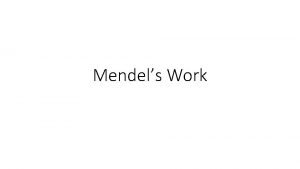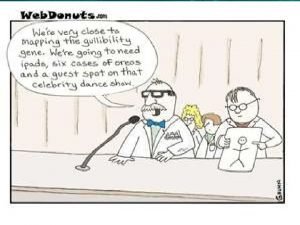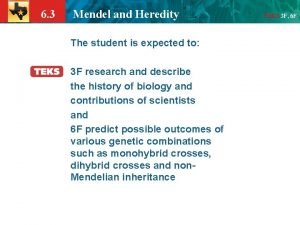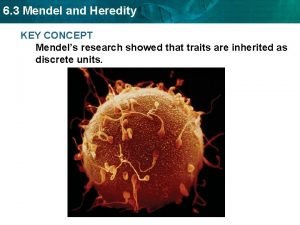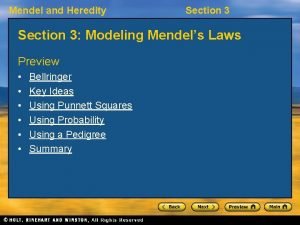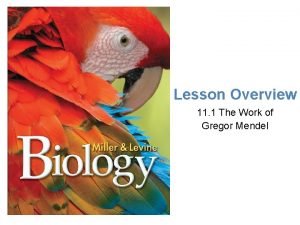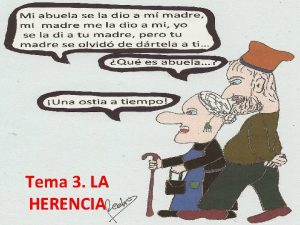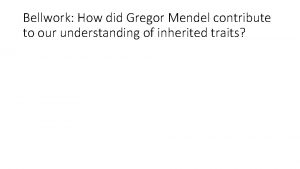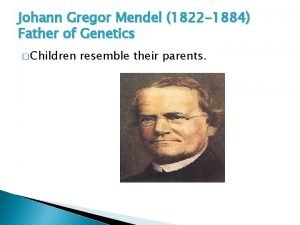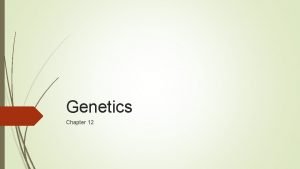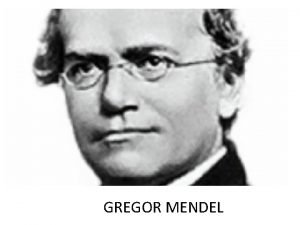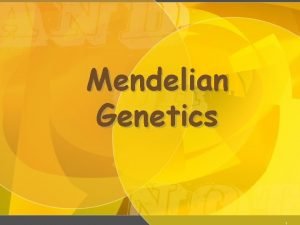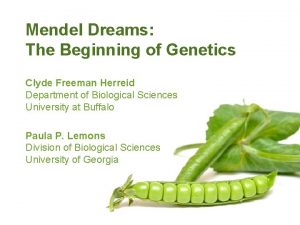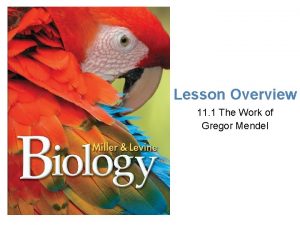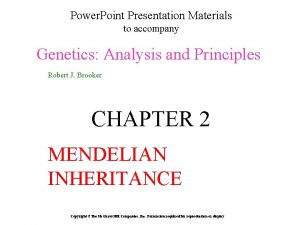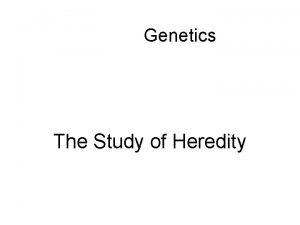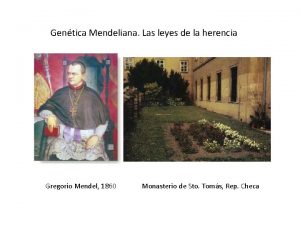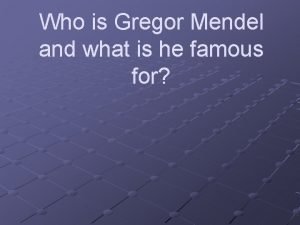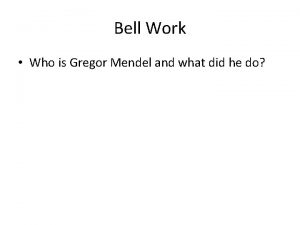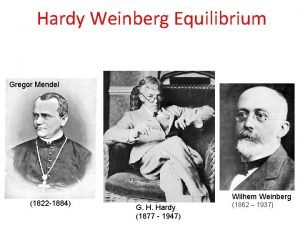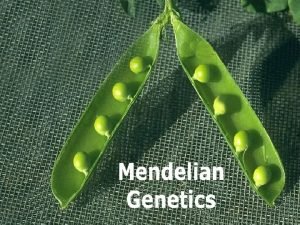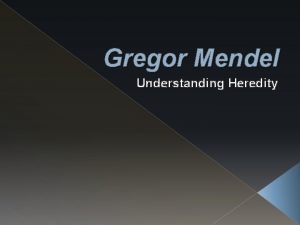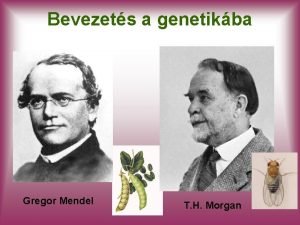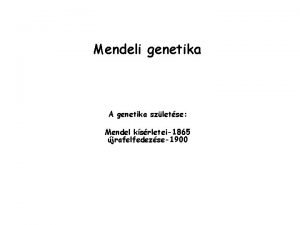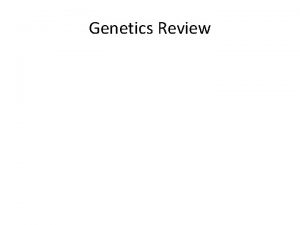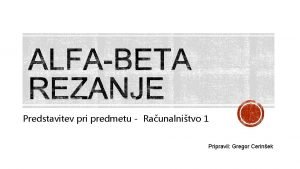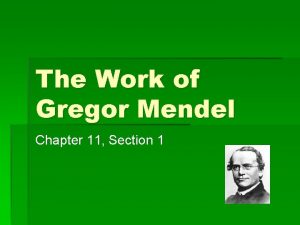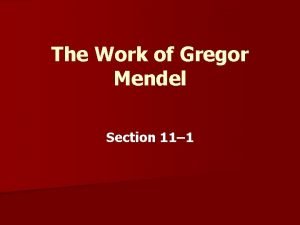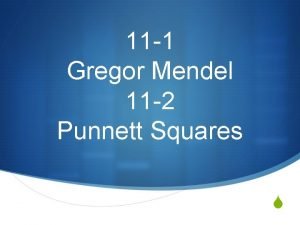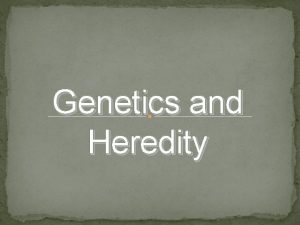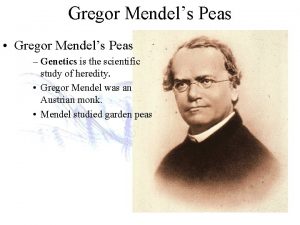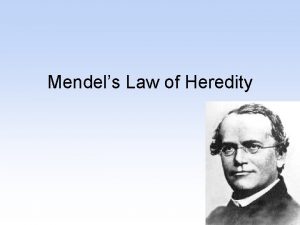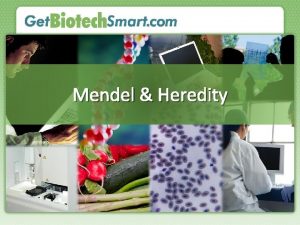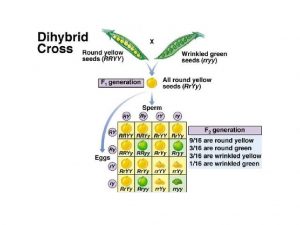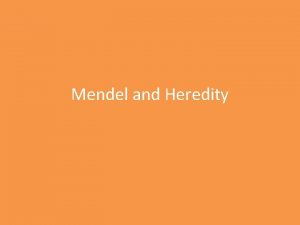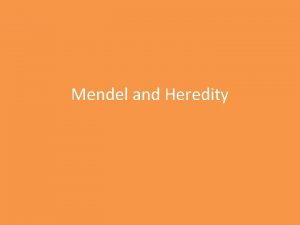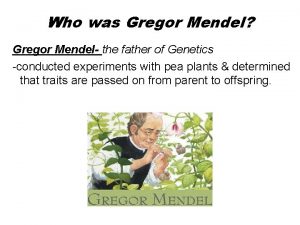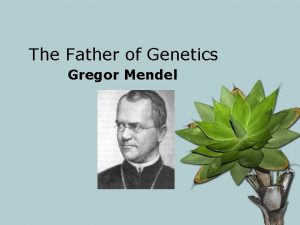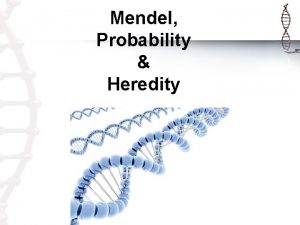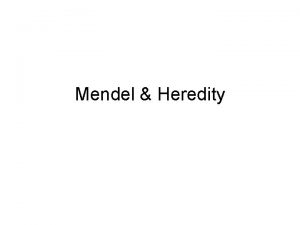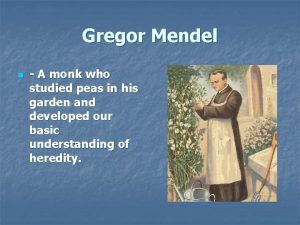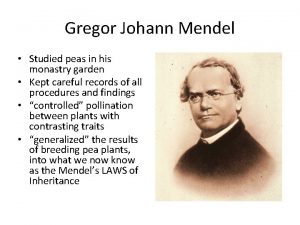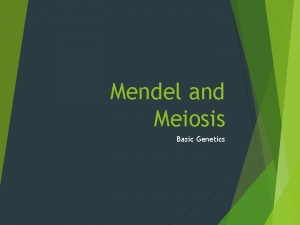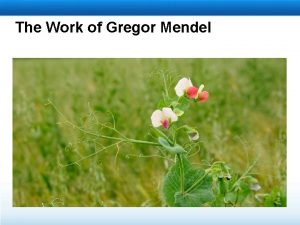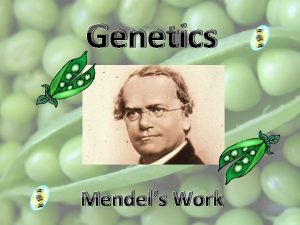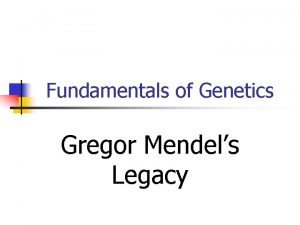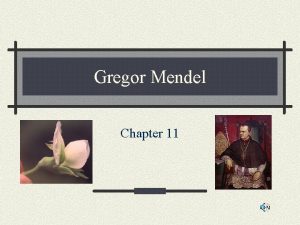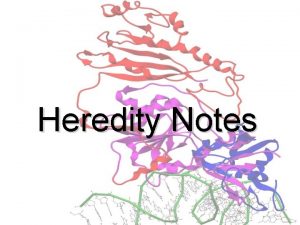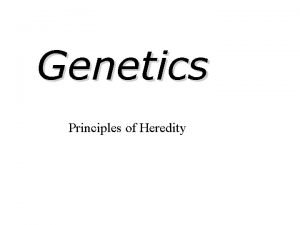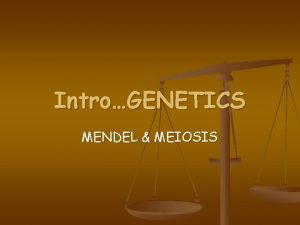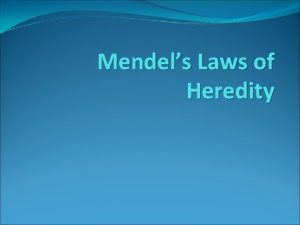GREGOR MENDEL father of heredity Mendels studied peas







































- Slides: 39

GREGOR MENDEL - father of heredity Mendel’s studied peas - good choice because self fertilizing crossed in controlled way definite traits short generation time

1 White Removed stamens from purple flower Stamens Carpel PARENTS (P) FLOWER COLOR Purple White Axial Terminal SEED COLOR Yellow Green SEED SHAPE Round Wrinkled POD SHAPE Inflated Constricted POD COLOR Green Yellow STEM LENGTH Tall Dwarf FLOWER POSITION 2 Transferred pollen Purple from stamens of white flower to carpel of purple flower 3 Pollinated carpel matured into pod 4 Planted seeds from pod OFFSPRING (F 1)


What Mendel did 1. 2. Crossed two plants ( parental generation) Saw all offspring had purple flowers 3. Then he mated the offspring. Their children were 75% purple 25% white

Can use a punnett square to explain his results

I Genetics A. Living things have different traits (ex. eye color) B. The passing of traits from parents to offspring is called heredity (genetics) (#1) C. Instructions for an inherited trait called genes (#2)

II. Genes A. Genes are segments of DNA on a chromosome B. Every person has same genes but their alleles for the gene will be different. C. Alleles are different forms of the gene (#3) For example everyone has a gene for eye color But one may have instructions for green eyes and one may have instructions for brown eyes

D. For example -Everyone has a gene for Tongue rolling But some can roll their tongue and some can not roll their tongues. E. You get a gene from your mother and a gene from your father.

F. Two types of alleles a. Dominant – stronger trait symbolized by a capital letter (#5) b. Recessive – weaker trait symbolized by a lower case letter (#6) example = tongue rolling T= tongue roller t= non-tongue roller TT Tt tt

III. Important vocabulary A. Homozygous ( pure bred) (#7) 1. same alleles 2. ex. TT or tt B. Heterozygous ( hybrid ) (#4) 1. two different alleles 2. ex. Tt

C. Genotype (#8) 1. genetic make-up 2. ex. TT , Tt or tt D. Phenotype (#9) 1. physical appearance 2. ex. tongue roller or non- tongue roller

IV. PUNNETT SQUARE Punnett square=a chart that shows all the possible combinations of alleles (#10) 1. Tells the probability the offspring will have a particular trait (#11) 2. Example T = Tongue roller t = Can’t roll tongue * tongue rolling is dominant

Parents TT (parent 1) X tt (parent 2) Upper case or capital letter is dominant Lower case or small letter is recessive

T t Parent 2 t Parent 1 T

T t Parent 2 t Tt Parent 1 T

T t Parent 2 t Tt Parent 1 T Tt

T t Tt Parent 2 Parent 1 T Tt

T Parent 1 T t Tt Tt Parent 2

Now you try it! Key: B = brown eyes = dominant b = blue eyes = recessive * brown is dominant to blue Upper case or capital letter is dominant Lower case or small letter is recessive

Parents Bb (parent 1) X Bb (parent 2)

B B Parent 2 b Parent 1 b

B B Parent 2 b BB Parent 1 b

B B Parent 2 b BB Parent 1 b Bb

B B BB b Bb Parent 2 Parent 1 b Bb

B Parent 1 b B BB Bb bb Parent 2

Genotype BB Bb bb Fraction 1/4 1/2 1/4 Percent 25% 50% 25% Ratio 1: 2: 1 Phenotype Fraction Percent Ratio brown eyes 3/4 75% 3: 1 blue eyes 1/4 25%

Other Information Humans have 46 chromosomes in each cell or 23 pairs. (#12) 50% of DNA comes from each parent #(13)

23 pairs of chromosomes that vary in size

You can trace your heritage by looking at the DNA in your mitochondria. A. For some reason, DNA in the mitochondria comes only from your mother (#14) B. Therefore your mitochondria is the same as your grandmother, & her mother

Egg and Sperm come together to produce a zygote (#15)

DNA carries the genetic information and is stored in the nucleus (#16)

DNA I. DNA (deoxyribonucleic acid) A. DNA is the genetic information B. Chromosomes - when DNA is coiled up. C. Chromatin - when the DNA looks like spaghetti

Test Your Knowlege

1. What are the structures where genes are located? a. Molecules b. Chromosomes c. nucleotides

2. The different forms of a gene that decides a characteristic are known as a. Alleles b. phenotypes c. genes

3. What is heredity? a. Traits passing from offspring to parents b. Traits passing from parents to offspring c. The ratio of dominant to recessive traits

4. • What ratio explains the purple flowers and white flower in the second generation? A. 3 to 1 B. 4 to 1

5. • Which of the following best describes the difference between the meanings of phenotype and genotype? a. A phenotype is the entire genetic makeup of an organism, whereas a genotype is the combination of genes for one specific trait b. a phenotype is the appearance of an organism, whereas a genotype is the genetic makeup of the organism

Practice Problem Yellow seeds are dominant to green seeds. Cross a heterozygous yellow seed and a homozygous green seed. What percent of the offspring will be yellow?
 What is this process called
What is this process called Pp x pp
Pp x pp Gregor mendels work
Gregor mendels work In the punnett square shown in figure 11-1
In the punnett square shown in figure 11-1 Section 3 mendel and heredity
Section 3 mendel and heredity Section 3 mendel and heredity
Section 3 mendel and heredity Section 3 mendel and heredity
Section 3 mendel and heredity Section 3 mendel and heredity
Section 3 mendel and heredity Section 3 mendel and heredity
Section 3 mendel and heredity Gregor mendel
Gregor mendel Generacion filial
Generacion filial How did gregor mendel contribute to genetics
How did gregor mendel contribute to genetics Gregor mendel
Gregor mendel Chapter 12 lesson 1 the work of gregor mendel
Chapter 12 lesson 1 the work of gregor mendel Gregor mendel
Gregor mendel Gregor mendel austrian monk
Gregor mendel austrian monk Rryy x rryy punnett square
Rryy x rryy punnett square Gregor mendel
Gregor mendel Gregor mendel summary
Gregor mendel summary Gregor mendel laws
Gregor mendel laws What did gregor mendel research
What did gregor mendel research Cruza dihibrida
Cruza dihibrida Who is gregor mendel and what is he famous for
Who is gregor mendel and what is he famous for Who is gregor mendel and what did he do?
Who is gregor mendel and what did he do? Chapter 11 biology review answers
Chapter 11 biology review answers Wilhem weinberg
Wilhem weinberg Austrian monk
Austrian monk Gregor mendel chart
Gregor mendel chart Fr gregor mendel
Fr gregor mendel Wo ist bach geboren
Wo ist bach geboren Gregor mendel
Gregor mendel Tesztelő keresztezés
Tesztelő keresztezés How many pairs of chromosomes do humans have? *
How many pairs of chromosomes do humans have? * Gregor mendel referat
Gregor mendel referat Chapter 11 the work of gregor mendel
Chapter 11 the work of gregor mendel Section 11.1 the work of gregor mendel
Section 11.1 the work of gregor mendel Tt x tt punnett square
Tt x tt punnett square Mendel
Mendel Gregor mendel video
Gregor mendel video Who is gregor mendel
Who is gregor mendel


